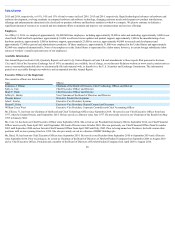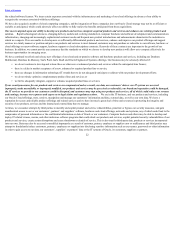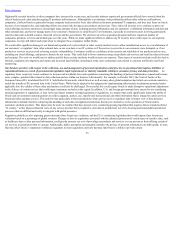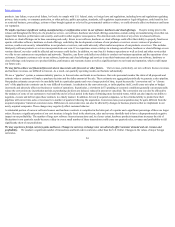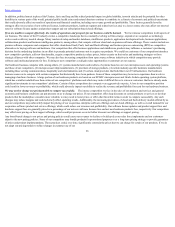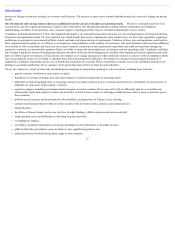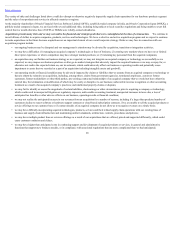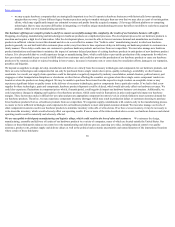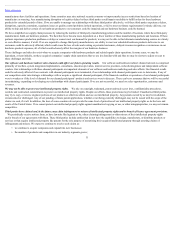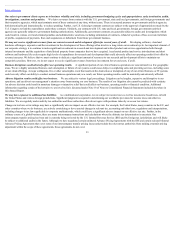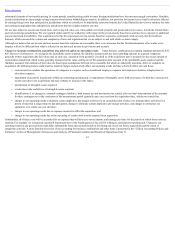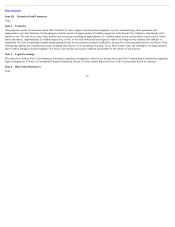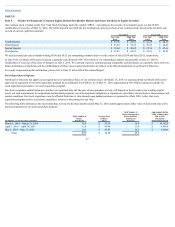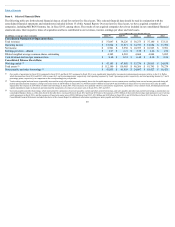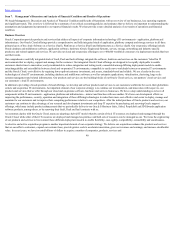Oracle 2015 Annual Report Download - page 32
Download and view the complete annual report
Please find page 32 of the 2015 Oracle annual report below. You can navigate through the pages in the report by either clicking on the pages listed below, or by using the keyword search tool below to find specific information within the annual report.
Table of Contents
• we may acquire hardware companies that are strategically important to us but (1) operate in hardware businesses with historically lower operating
margins than our own; (2) have different legacy business practices and go-to-market strategies than our own that we may alter as a part of our integration
efforts, which may significantly impact our estimated revenues and profits from the acquired company; (3) leverage different platforms or competing
technologies that we may encounter difficulties in integrating; or (4) utilize unique manufacturing processes that affect our ability to scale these acquired
products within our own manufacturing operations.
Our hardware offerings are complex products, and if we cannot successfully manage this complexity, the results of our hardware business will suffer.
Designing, developing, manufacturing and introducing new hardware products are complicated processes. The development process for our hardware products is
uncertain and requires a high level of innovation. After the development phase, we must be able to forecast customer demand and manufacture new hardware
products in sufficient volumes to meet this demand and do so in a cost-effective manner. Our “build-to-order” manufacturing model, in which our hardware
products generally are not built until after customers place orders, may from time to time experience delays in delivering our hardware products to customers in a
timely manner. These delays could cause our customers to purchase hardware products and services from our competitors. We must also manage new hardware
product introductions and transitions to minimize the impact of customer delayed purchases of existing hardware products in anticipation of new hardware product
releases. It is also possible that we could experience design or manufacturing flaws, which could delay or prevent the production of the components for which we
have previously committed to pay or need to fulfill orders from customers and could also prevent the production of our hardware products or cause our hardware
products to be returned, recalled or rejected resulting in lost revenues, increases in warranty costs or costs related to remediation efforts, damage to our reputation,
penalties and litigation.
We depend on suppliers to design, develop, manufacture and deliver on a timely basis the necessary technologies and components for our hardware products, and
there are some technologies and components that can only be purchased from a single vendor due to price, quality, technology, availability or other business
constraints. As a result, our supply chain operations could be disrupted or negatively impacted by industry consolidation, natural disasters, political unrest, port
stoppages or other transportation disruptions or slowdowns or other factors affecting the countries or regions where these single source component vendors are
located or where the products are being shipped. We may be unable to purchase these items from the respective single vendors on acceptable terms or may
experience significant delays or quality issues in the delivery of necessary technologies, parts or components from a particular vendor. If we had to find a new
supplier for these technologies, parts and components, hardware product shipments could be delayed, which would adversely affect our hardware revenues. We
could also experience fluctuations in component prices which, if unanticipated, could negatively impact our hardware business cost structure. Additionally, we
could experience changes in shipping and logistics of our hardware products, which could result in fluctuations in prices and negatively impact our hardware
margins. These factors may make it difficult for us to plan and procure appropriate component inventory levels in a timely fashion to meet customer demand for
our hardware products. Therefore, we may experience component inventory shortages which may result in production delays or customers choosing to purchase
fewer hardware products from us or hardware products from our competitors. We negotiate supply commitments with vendors early in the manufacturing process
to ensure we have sufficient technologies and components for our hardware products to meet anticipated customer demand. We must also manage our levels of
older component inventories used in our hardware products to minimize inventory write-offs or write-downs. If we have excess inventory, it may be necessary to
write-down the inventory, which would adversely affect our operating results. If one or more of the risks described above occurs, our hardware business and related
operating results could be materially and adversely affected.
We are susceptible to third-party manufacturing and logistics delays, which could result in the loss of sales and customers. We outsource the design,
manufacturing, assembly and delivery of certain of our hardware products to a variety of companies, many of which are located outside the United States. Our
reliance on these third parties reduces our control over the manufacturing and delivery process, exposing us to risks, including reduced control over quality
assurance, product costs, product supply and delivery delays as well as the political and economic uncertainties and natural disasters of the international locations
where certain of these third-party
30


